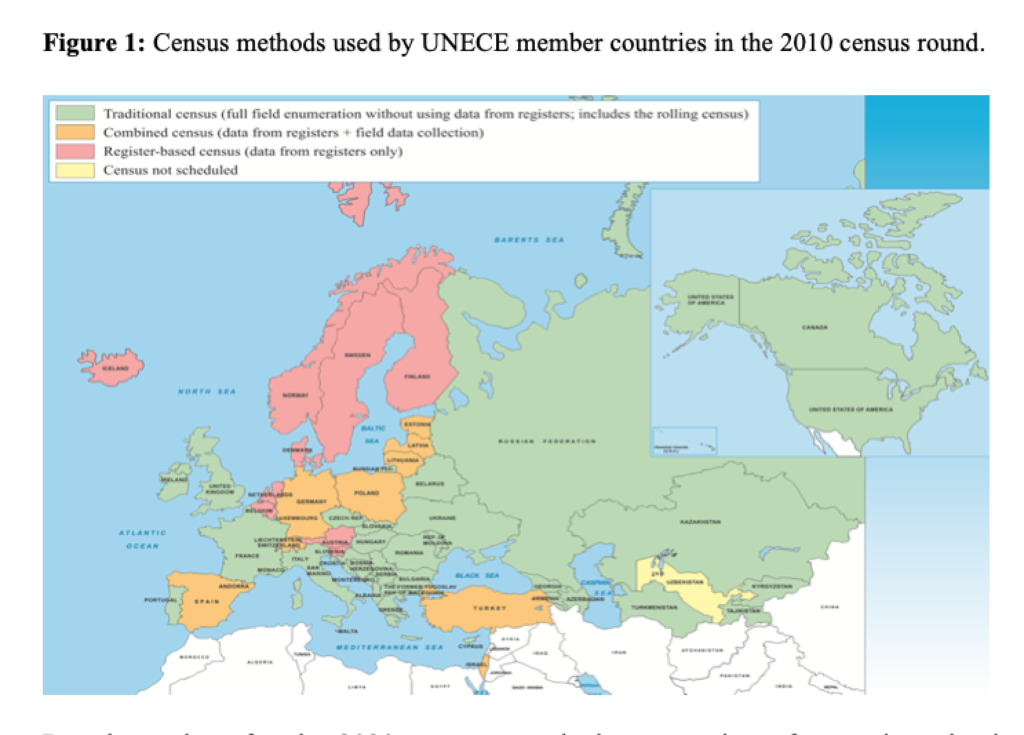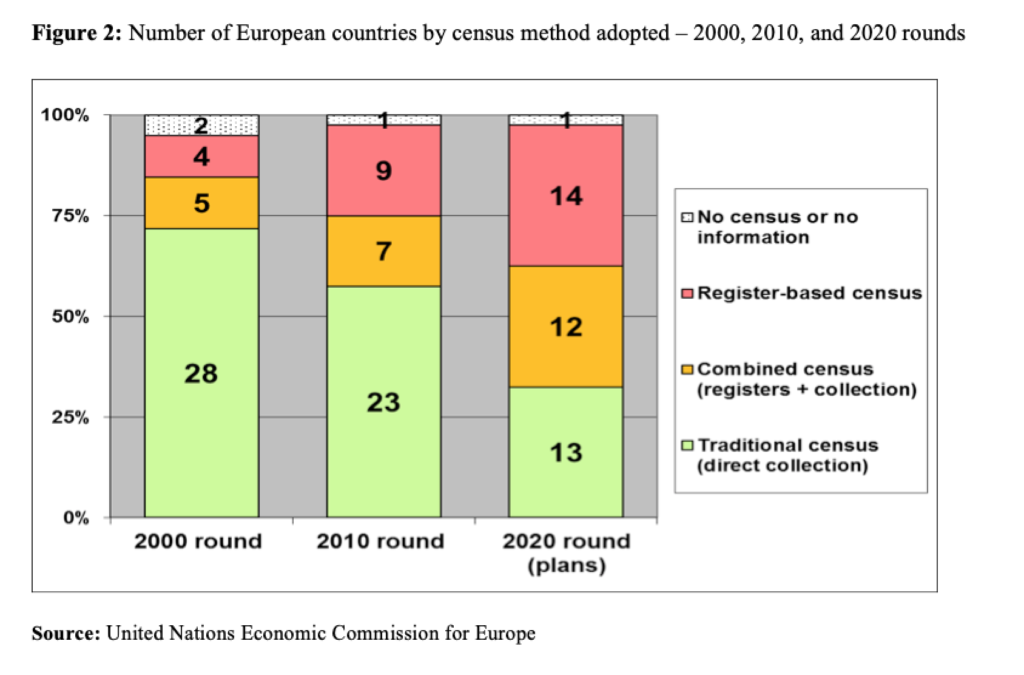For the 2020 census round, Paolo Valente informs us that two-thirds of European countries plan to increase efficiency by using methods other than the traditional census based on paper questionnaires. Registers will be used extensively, as the only data source, or in combination with a limited data collection. Information Technology (IT), including Internet response and tablets for field collection, will play a major role.
The traditional census approach and its shortcomings
Population censuses are conducted in virtually all countries for administrative, planning and statistical purposes. In modern times and until the 1960s, all European countries conducted population censuses adopting the same “traditional” approach, based on the collection of information on individuals and households using paper forms distributed and collected by enumerators.
Conducting a traditional census with paper forms is an extremely expensive and complex operation: a very large temporary work force has to be recruited and trained; a huge number of forms must be printed, distributed, and collected; data have to be entered (often manually), processed, edited, and tabulated. Due to the high costs and complexity involved, the traditional census is generally conducted every 10 years, so both the frequency and timeliness of the census results are unsatisfactory for many users. In recent years, additional problems associated with the traditional census have emerged in many countries, including the increasing reluctance of the population to participate in the census and the difficulty of enumerating certain population groups, particularly those characterized by high mobility and multiple residences (e.g. students and young professionals).
Variants of the traditional census approach
Various solutions have been developed over time to overcome the problems of the traditional census.
- One of them consists of using two different forms: a long form used to collect detailed information from a sample, and a short form used for the rest of the population, to collect only very general information. With this method, the amount of information collected and processed is substantially reduced, resulting in lower costs, reduced complexity, and more timely publication of the results. However, for the variables present only in the long form, the level of detail is limited, as only a sample of the population is covered.
- Starting in the late 1990s, some countries developed the internet response option in a traditional census in order to improve coverage and data quality, shorten data processing time, and potentially reduce costs if the take-up rate is high. This option was offered by few countries in the 2000 census round, and by a much larger number in the 2010 round, sometimes with very high take-up rates (67% in Estonia).
- To increase the efficiency of field collection, many countries are replacing paper forms with IT solutions, making use of laptops or tablets, often as part of “paperless census” strategies.
- An original solution has been implemented in France since 2004 in the form of a rolling census conducted as a cumulative continuous survey over a long period. In France a five-year cycle was adopted, along with two different strategies: small municipalities (population under 10,000) are divided into five groups, and a full census is conducted each year in one of the groups; in large municipalities a sample survey is conducted each year. By the end of the five-year cycle, about 70% of the country’s population has been enumerated. This is enough to guarantee robust information at municipality and neighbourhood levels. The census results are based on rolling averages calculated over the five-year cycle, and are updated yearly.
The register-based census
A totally different approach has been developed by the Nordic countries. Since the 1970s, the census enumeration has been replaced by administrative data drawn from various registers (population register, cadastre, social security, etc.) through a matching process, making use of personal identification numbers.
To adopt this approach, a number of requirements must be met: registers must include all census variables with sufficient levels of coverage and quality; the public must accept the register-based statistical system; the legal framework must make provision for access, use and matching of register data and personal identification numbers; there must be good cooperation between the statistical office and the authorities responsible for the registers; large initial investments and a long development time are needed to set up and maintain the system. Once the system is established, data for the census and for other statistical activities can be produced at a limited cost and with limited effort. Moreover, there is no burden on respondents, and data are potentially available every year.
The combined census
Many countries have population and other registers that could be used for the census, but their coverage or data are not of sufficient quality for a register-based census, or some key census variables are not available. For the 2000 round, some countries decided to produce census results using register data combined with a limited field collection.
Different approaches to this “combined census” exist. Data from registers can be combined with data from an ad hoc sample survey in order to both evaluate the coverage and quality of registers and to collect information on topics not covered in registers, or for which their coverage or quality is inadequate.
Alternatively, register data can be combined with other data obtained from a full enumeration (instead of an ad hoc sample survey). For the variables concerned, detailed information becomes available, but the cost and complexity of data collection are higher.
Evolution of census methods over time in Europe
For the 2010 census round, several countries in Europe conducted a register-based census or a combined census. However, the traditional method was still the most popular approach, adopted by about 60% of the countries in Europe (figure 1).

Based on plans for the 2020 census round, the proportion of countries adopting an alternative method (register-based or combined census) will increase significantly from about one-quarter in the 2000 round to two-thirds (figure 2).

Multi-mode approaches: challenges and future developments
Many of the approaches described above imply the use of multiple data sources and/or multiple collection modes. In a traditional census, for instance, countries may combine internet response, field collection with tablets in large cities, and paper-based interviews in remote regions. In a combined census, data can be derived from administrative sources and an ad hoc field collection.
Multi-mode approaches make use of existing data sources and technologies that may be available only in some parts of a country. This may potentially increase the census efficiency in terms of response rate, coverage, data quality, and costs. However, a multi-mode approach also implies challenges and risks. A response tracking system must be set up to record in real time the responses received via the different modes, and to share this information with field workers.
In the future, more countries will probably adopt alternative methods based on multiple sources and collection methods. However, in some countries the traditional census may continue to be the best solution.
A possible development for future censuses is the use – in combination with other sources – of “big data”. Various countries have already tested this approach for the 2020 census round, but there are still many methodological, legal, quality and IT challenges to be addressed.
References
UNECE: Register-based statistics in the Nordic countries – Review of best practices with focus on population and social statistics, United Nations, New York and Geneva (2007). Cited 20 Feb 2019
UNECE: Conference of European Statisticians Recommendations for the 2020 Censuses of Population and Housing, United Nations, New York and Geneva (2015).
UNECE: Guidelines on the use of registers and administrative data for population and housing censuses, United Nations, New York and Geneva (2018).
UNECE: Wiki table on the 2020 census round (2019): Cited 20 Feb 2019
Valente, P.: Censuses: Current Approaches and Methods. In: James D. Wright (editor-in-chief), International Encyclopedia of the Social & Behavioral Sciences, 2nd edition, Vol 3, pp. 296–301. Elsevier, Oxford (2015)


